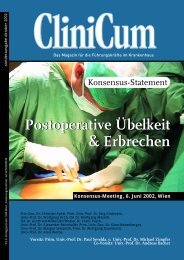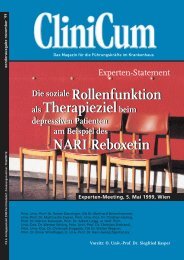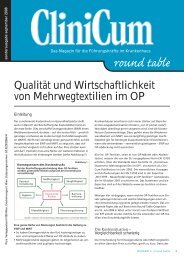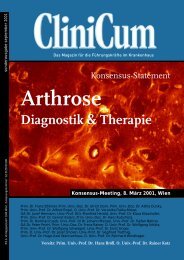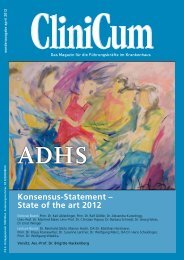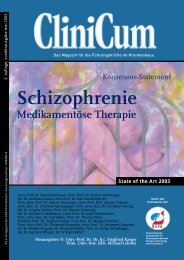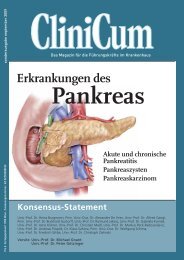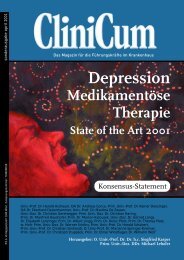Elevated Monoamine Oxidase A Levels in the Brain - Medizin ...
Elevated Monoamine Oxidase A Levels in the Brain - Medizin ...
Elevated Monoamine Oxidase A Levels in the Brain - Medizin ...
You also want an ePaper? Increase the reach of your titles
YUMPU automatically turns print PDFs into web optimized ePapers that Google loves.
ORIGINAL ARTICLE<br />
<strong>Elevated</strong> <strong>Monoam<strong>in</strong>e</strong> <strong>Oxidase</strong> A <strong>Levels</strong> <strong>in</strong> <strong>the</strong> Bra<strong>in</strong><br />
An Explanation for <strong>the</strong> <strong>Monoam<strong>in</strong>e</strong> Imbalance of Major Depression<br />
Jeffrey H. Meyer, MD, PhD; Nathalie G<strong>in</strong>ovart, PhD; Anahita Boovariwala, BSc; Sandra Sagrati, BSc;<br />
Doug Hussey, BSc; Armando Garcia, BSc; Trevor Young, MD, PhD; Nicole Praschak-Rieder, MD;<br />
Alan A. Wilson, PhD; Sylva<strong>in</strong> Houle, MD, PhD<br />
Context: The monoam<strong>in</strong>e <strong>the</strong>ory of depression proposes<br />
that monoam<strong>in</strong>e levels are lowered, but <strong>the</strong>re is no<br />
explanation for how monoam<strong>in</strong>e loss occurs. <strong>Monoam<strong>in</strong>e</strong><br />
oxidase A (MAO-A) is an enzyme that metabolizes<br />
monoam<strong>in</strong>es, such as seroton<strong>in</strong>, norep<strong>in</strong>ephr<strong>in</strong>e, and<br />
dopam<strong>in</strong>e.<br />
Objective: To determ<strong>in</strong>e whe<strong>the</strong>r MAO-A levels <strong>in</strong> <strong>the</strong><br />
bra<strong>in</strong> are elevated dur<strong>in</strong>g untreated depression.<br />
Sett<strong>in</strong>g: Tertiary care psychiatric hospital.<br />
Patients: Seventeen healthy and 17 depressed <strong>in</strong>dividuals<br />
with major depressive disorder that met entry criteria<br />
were recruited from <strong>the</strong> care of general practitioners<br />
and psychiatrists. All study participants were o<strong>the</strong>rwise<br />
healthy and nonsmok<strong>in</strong>g. Depressed <strong>in</strong>dividuals had been<br />
medication free for at least 5 months.<br />
Ma<strong>in</strong> Outcome Measure: Harm<strong>in</strong>e labeled with carbon<br />
11, a radioligand selective for MAO-A and positron<br />
Author Affiliations: Vivian M.<br />
Rakoff PET Imag<strong>in</strong>g Centre<br />
(Drs Meyer, G<strong>in</strong>ovart,<br />
Praschak-Rieder, Wilson, and<br />
Houle, Mss Boovariwala and<br />
Sagrati, and Messrs Hussey and<br />
Garcia) and Mood and Anxiety<br />
Disorders Division (Drs Meyer<br />
and Young), Clarke Division,<br />
Centre for Addiction and<br />
Mental Health and Department<br />
of Psychiatry, University of<br />
Toronto, Toronto, Ontario; and<br />
Department of General<br />
Psychiatry, Medical University<br />
of Vienna, Vienna, Austria<br />
(Dr Praschak-Rieder).<br />
MAJOR DEPRESSIVE DISORder<br />
is an important illness<br />
because it has a<br />
1-year prevalence of 2%<br />
to 5% and ranks fourth<br />
among causes of death or <strong>in</strong>jury. 1 For more<br />
than 30 years, it has been <strong>the</strong>orized that levels<br />
of monoam<strong>in</strong>es, such as seroton<strong>in</strong>, norep<strong>in</strong>ephr<strong>in</strong>e,<br />
and dopam<strong>in</strong>e, are generally<br />
low <strong>in</strong> <strong>the</strong> bra<strong>in</strong> dur<strong>in</strong>g untreated major depressive<br />
episodes (MDEs). 2 However, no<br />
conv<strong>in</strong>c<strong>in</strong>g mechanism of monoam<strong>in</strong>e loss<br />
has ever been found. 3-11<br />
Previous <strong>in</strong>vestigations of monoam<strong>in</strong>e<br />
transporters and monoam<strong>in</strong>e syn<strong>the</strong>sis<br />
enzymes have not identified a prom<strong>in</strong>ent<br />
monoam<strong>in</strong>e-lower<strong>in</strong>g process dur<strong>in</strong>g<br />
untreated depressive episodes. Loss of<br />
monoam<strong>in</strong>e-releas<strong>in</strong>g neurons is an unlikely<br />
mechanism of monoam<strong>in</strong>e loss, s<strong>in</strong>ce<br />
some <strong>in</strong>vestigations report no reduction<br />
<strong>in</strong> monoam<strong>in</strong>e transporters and <strong>the</strong> largest<br />
reported reductions <strong>in</strong> monoam<strong>in</strong>e<br />
transporter density <strong>in</strong>dices range from 14%<br />
to 25%. 3-8,12,13 Even <strong>the</strong> largest reported re-<br />
emission tomography, was used to measure MAO-A DV S<br />
(specific distribution volume), an <strong>in</strong>dex of MAO-A density,<br />
<strong>in</strong> different bra<strong>in</strong> regions (prefrontal cortex, anterior<br />
c<strong>in</strong>gulate cortex, posterior c<strong>in</strong>gulate cortex, caudate,<br />
putamen, thalamus, anterior temporal cortex,<br />
midbra<strong>in</strong>, hippocampus, and parahippocampus).<br />
Results: The MAO-A DV S was highly significantly elevated<br />
<strong>in</strong> every bra<strong>in</strong> region assessed (t test; P=.001 to<br />
3�10 −7 ). The MAO-A DVS was elevated on average by 34%<br />
(2 SDs) throughout <strong>the</strong> bra<strong>in</strong> dur<strong>in</strong>g major depression.<br />
Conclusions: The sizable magnitude of this f<strong>in</strong>d<strong>in</strong>g<br />
and <strong>the</strong> absence of o<strong>the</strong>r compell<strong>in</strong>g explanations for<br />
monoam<strong>in</strong>e loss dur<strong>in</strong>g major depressive episodes led<br />
to <strong>the</strong> conclusion that elevated MAO-A density is <strong>the</strong><br />
primary monoam<strong>in</strong>e-lower<strong>in</strong>g process dur<strong>in</strong>g major<br />
depression.<br />
Arch Gen Psychiatry. 2006;63:1209-1216<br />
(REPRINTED) ARCH GEN PSYCHIATRY/ VOL 63, NOV 2006 WWW.ARCHGENPSYCHIATRY.COM<br />
1209<br />
©2006 American Medical Association. All rights reserved.<br />
ductions <strong>in</strong> monoam<strong>in</strong>e transporter <strong>in</strong>dices<br />
<strong>in</strong> depression are low compared with<br />
monoam<strong>in</strong>e transporter loss observed <strong>in</strong><br />
symptomatic neurodegenerative disease.<br />
14 Moreover, no abnormality <strong>in</strong> an <strong>in</strong>dex<br />
of seroton<strong>in</strong> transporter density was<br />
found <strong>in</strong> vivo <strong>in</strong> untreated depressed <strong>in</strong>dividuals.<br />
8 Decreased monoam<strong>in</strong>e syn<strong>the</strong>sis<br />
is unlikely dur<strong>in</strong>g depression because<br />
<strong>in</strong>vestigations of monoam<strong>in</strong>e syn<strong>the</strong>sis enzymes<br />
<strong>in</strong> monoam<strong>in</strong>e nuclei tend to f<strong>in</strong>d<br />
no change or modest <strong>in</strong>creases <strong>in</strong> depressed<br />
<strong>in</strong>dividuals. 10,11,15 Studies 9 attempt<strong>in</strong>g<br />
to determ<strong>in</strong>e whe<strong>the</strong>r monoam<strong>in</strong>e precursor<br />
uptake is reduced <strong>in</strong> depression are<br />
<strong>in</strong>conclusive because <strong>the</strong>y are typically<br />
confounded by recent antidepressant use.<br />
Abnormally elevated monoam<strong>in</strong>e oxidase<br />
B density seems less likely to occur<br />
<strong>in</strong> depression, as one <strong>in</strong>vestigation 16 of<br />
monoam<strong>in</strong>e oxidase B density <strong>in</strong> <strong>the</strong> amygdala<br />
found no significant difference <strong>in</strong> depressed<br />
<strong>in</strong>dividuals.<br />
<strong>Monoam<strong>in</strong>e</strong> oxidase A (MAO-A) is a<br />
logical enzyme to <strong>in</strong>vestigate <strong>in</strong> depres-
Activity, kBq/mL<br />
Activity, kBq/mL<br />
35<br />
30<br />
25<br />
20<br />
15<br />
10<br />
5<br />
0<br />
30<br />
25<br />
20<br />
15<br />
10<br />
5<br />
0<br />
Prefrontal Cortex<br />
0 20 40 60 80 100<br />
Time, m<strong>in</strong><br />
Anterior C<strong>in</strong>gulate Cortex<br />
0 20 40 60 80 100<br />
Time, m<strong>in</strong><br />
sion because it regulates levels of all 3 major monoam<strong>in</strong>es<br />
(seroton<strong>in</strong>, norep<strong>in</strong>ephr<strong>in</strong>e, and dopam<strong>in</strong>e) <strong>in</strong> <strong>the</strong> bra<strong>in</strong>. 17<br />
Whe<strong>the</strong>r MAO-A levels <strong>in</strong> <strong>the</strong> bra<strong>in</strong> are abnormal dur<strong>in</strong>g<br />
MDEs is unknown because each previous <strong>in</strong>vestigation of<br />
MAO-A <strong>in</strong> <strong>the</strong> bra<strong>in</strong> has had at least 2 critical confounders<br />
and/or limitations, 18-23 <strong>in</strong>clud<strong>in</strong>g complete nonspecificity<br />
of technique for MAO-A vs monoam<strong>in</strong>e oxidase B, enrollment<br />
of study participants who had recently taken medication,<br />
unclear diagnosis of <strong>in</strong>dividuals who committed suicide,<br />
small sample size, and lack of differentiation between<br />
early-onset depression and late-onset depression. In contrast<br />
to <strong>the</strong> typical, early-onset depression before <strong>the</strong> age<br />
of 40 years, late-onset depression probably has a different<br />
pathophysiologic mechanism attributable to lesions and/or<br />
degenerative disease. 24<br />
The MAO-A DV S (specific distribution volume), an <strong>in</strong>dex<br />
of MAO-A density, is measurable <strong>in</strong> vivo <strong>in</strong> <strong>the</strong> bra<strong>in</strong><br />
us<strong>in</strong>g harm<strong>in</strong>e labeled with carbon 11 ([ 11 C]harm<strong>in</strong>e) posi-<br />
Activity, kBq/mL<br />
Activity, kBq/mL<br />
40<br />
35<br />
30<br />
25<br />
20<br />
15<br />
10<br />
5<br />
0<br />
30<br />
25<br />
20<br />
15<br />
10<br />
5<br />
0<br />
Thalamus<br />
0 20 40 60 80 100<br />
Time, m<strong>in</strong><br />
Temporal Cortex<br />
0 20 40 60 80 100<br />
Time, m<strong>in</strong><br />
Figure 1. Time activity curves for harm<strong>in</strong>e labeled with carbon 11 ([ 11 C]harm<strong>in</strong>e) demonstrat<strong>in</strong>g reversible k<strong>in</strong>etics. Time activity curves for a representative<br />
depressed <strong>in</strong>dividual (closed circles) and a healthy <strong>in</strong>dividual (open circles) are shown. This pair of study participants was chosen because each has monoam<strong>in</strong>e<br />
oxidase A (MAO-A) DV S (an <strong>in</strong>dex of MAO-A density) values with<strong>in</strong> 10% of <strong>the</strong>ir group mean, and <strong>the</strong>se 2 participants have near identical areas under <strong>the</strong>ir<br />
[ 11 C]harm<strong>in</strong>e plasma <strong>in</strong>put curves (with<strong>in</strong> 1%).<br />
tron emission tomography (PET). 25,26 [ 11 C]Harm<strong>in</strong>e is a<br />
selective, reversible PET radiotracer for MAO-A, and<br />
MAO-A DVS is an <strong>in</strong>dex of specifically bound [ 11 C]harm<strong>in</strong>e.<br />
25-27 [ 11 C]Harm<strong>in</strong>e PET demonstrates <strong>the</strong> requisite<br />
properties of a PET radiotracer for measurement of MAO-<br />
A 25-27 : harm<strong>in</strong>e has a high aff<strong>in</strong>ity (Ki=2nM) and a selective<br />
aff<strong>in</strong>ity for <strong>the</strong> MAO-A enzyme. [ 11 C]Harm<strong>in</strong>e shows<br />
high bra<strong>in</strong> uptake <strong>in</strong> humans with <strong>the</strong> greatest uptake <strong>in</strong><br />
regions with <strong>the</strong> highest MAO-A density. 25-27 [ 11 C]Harm<strong>in</strong>e<br />
also shows reversible k<strong>in</strong>etics <strong>in</strong> all regions with specific<br />
b<strong>in</strong>d<strong>in</strong>g <strong>in</strong> humans 25-27 (Figure 1). The MAO-A <strong>in</strong>hibitors<br />
can fully displace specific b<strong>in</strong>d<strong>in</strong>g of [ 11 C]harm<strong>in</strong>e<br />
<strong>in</strong> animal models, 25,27 and MAO-A <strong>in</strong>hibitors at cl<strong>in</strong>ically<br />
tolerable doses can displace 80% of specific b<strong>in</strong>d<strong>in</strong>g <strong>in</strong> humans.<br />
26 The metabolites of harm<strong>in</strong>e are polar and do not<br />
cross <strong>the</strong> blood-bra<strong>in</strong> barrier. 28 The ma<strong>in</strong> advantage of<br />
[ 11 C]harm<strong>in</strong>e over clorgyl<strong>in</strong>e labeled with carbon 11<br />
([ 11 C]clorgyl<strong>in</strong>e) is that [ 11 C]harm<strong>in</strong>e has reversible bra<strong>in</strong><br />
(REPRINTED) ARCH GEN PSYCHIATRY/ VOL 63, NOV 2006 WWW.ARCHGENPSYCHIATRY.COM<br />
1210<br />
©2006 American Medical Association. All rights reserved.
k<strong>in</strong>etics, whereas [ 11 C]clorgyl<strong>in</strong>e shows slowly reversible<br />
bra<strong>in</strong> k<strong>in</strong>etics. 29 The ma<strong>in</strong> advantage of [ 11 C]harm<strong>in</strong>e over<br />
deuterium-substituted [ 11 C]clorgyl<strong>in</strong>e is that deuteriumsubstituted<br />
[ 11 C]clorgyl<strong>in</strong>e has substantial non–MAO-A<br />
b<strong>in</strong>d<strong>in</strong>g <strong>in</strong> humans <strong>in</strong> some bra<strong>in</strong> regions. 29<br />
The hypo<strong>the</strong>sis of <strong>the</strong> present study is that <strong>the</strong> MAO-A<br />
DVS will be elevated throughout <strong>the</strong> bra<strong>in</strong> dur<strong>in</strong>g MDEs<br />
<strong>in</strong> medication-free <strong>in</strong>dividuals with major depressive disorder<br />
and typical early-onset illness. An elevation <strong>in</strong> MAO-A<br />
density is hypo<strong>the</strong>sized because greater MAO-A could excessively<br />
lower bra<strong>in</strong> monoam<strong>in</strong>e levels. 17 The location of<br />
elevated MAO-A density was hypo<strong>the</strong>sized to be throughout<br />
<strong>the</strong> bra<strong>in</strong> because monoam<strong>in</strong>e receptor abnormalities<br />
<strong>in</strong> depression consistent with lowered monoam<strong>in</strong>e levels<br />
have been reported <strong>in</strong> several bra<strong>in</strong> regions, <strong>in</strong>clud<strong>in</strong>g <strong>the</strong><br />
prefrontal cortex, striatum, and midbra<strong>in</strong>. 3-6,8,30<br />
METHODS<br />
PARTICIPANTS<br />
Twenty <strong>in</strong>dividuals with an MDE and major depressive disorder<br />
were recruited, and 17 depressed <strong>in</strong>dividuals completed <strong>the</strong><br />
protocol (mean±SD age, 34±8 years; 8 men and 9 women).<br />
Seventeen age-matched healthy <strong>in</strong>dividuals were recruited<br />
(mean±SD age, 34±8 years; 10 men and 7 women). Each underwent<br />
an [ 11 C]harm<strong>in</strong>e PET scan. Participants were between<br />
20 and 49 years of age. Healthy participants were age<br />
matched with<strong>in</strong> 4 years to depressed patients (Table).<br />
Allstudyparticipants(MDEandhealthy)werephysicallyhealthy<br />
and nonsmok<strong>in</strong>g and had no history of neurotox<strong>in</strong> use. Participants<br />
were nonsmok<strong>in</strong>g because it is reported that smok<strong>in</strong>g can<br />
lower MAO-A levels, which could create greater variance <strong>in</strong> measurement.<br />
31 Women <strong>in</strong> perimenopause or menopause were excluded.<br />
Healthy participants were screened to rule out any Axis<br />
I disorders, and depressed participants were screened to rule out<br />
any comorbid Axis I disorders us<strong>in</strong>g <strong>the</strong> Structured Cl<strong>in</strong>ical Interview<br />
for DSM-IV. 32 All participants were screened to rule out<br />
borderl<strong>in</strong>eandantisocialpersonalitydisorderus<strong>in</strong>g<strong>the</strong>Structured<br />
Cl<strong>in</strong>ical Interview for DSM-IV for Axis II disorders. 33 All participants<br />
underwent a ur<strong>in</strong>e drug screen on <strong>the</strong> day of <strong>the</strong> [ 11 C]harm<strong>in</strong>e<br />
PET scan. All depressed patients underwent common blood<br />
tests to rule out medical causes of disturbed mood (thyroid function,<br />
electrolyte levels, and complete blood cell count).<br />
For depressed patients, <strong>the</strong> mean±SD age at onset of illness<br />
was 23±10 years. Patients were <strong>in</strong> <strong>the</strong>ir first (n=8), second<br />
(n=5), or third (n=4) MDE. No patient with depression<br />
had received antidepressant treatment with<strong>in</strong> <strong>the</strong> past 5 months,<br />
and 11 depressed patients had never received antidepressant<br />
treatment. For depressed patients, a diagnosis of MDE secondary<br />
to major depressive disorder was based on <strong>the</strong> Structured<br />
Cl<strong>in</strong>ical Interview for DSM-IV for Axis I disorders 32 and a consultation<br />
with a psychiatrist (J.H.M.). For patients with MDE,<br />
<strong>the</strong> m<strong>in</strong>imum severity for enrollment was based on a cutoff score<br />
of 17 on <strong>the</strong> 17-item Hamilton Depression Rat<strong>in</strong>g Scale. 34 The<br />
mean±SD Hamilton Depression Rat<strong>in</strong>g Scale score for participants<br />
with MDE was 22±3. Additional exclusion criteria <strong>in</strong>cluded<br />
MDE with psychotic symptoms, bipolar disorder (type<br />
I or II), history of self-harm or suicidality outside episodes of<br />
depression, and history of alcohol or o<strong>the</strong>r drug abuse.<br />
For each study participant, written consent was obta<strong>in</strong>ed<br />
after <strong>the</strong> procedures had been fully expla<strong>in</strong>ed. The study and<br />
recruitment procedures were approved by <strong>the</strong> Research Ethics<br />
Board for Human Subjects at <strong>the</strong> Centre for Addiction and Mental<br />
Health, University of Toronto.<br />
Table. Sample Demographics<br />
Demographic<br />
Healthy<br />
Group<br />
(n = 17)<br />
Depressed<br />
Group<br />
(n = 17)<br />
Age, mean ± SD, y 34 ± 8 34 ± 8<br />
Women, No. 7 9<br />
Men, No. 10 8<br />
Education, mean ± SD, y 15 ± 2 15 ± 2<br />
Psychiatric diagnosis* None Major depressive episode;<br />
major depressive disorder<br />
First major depressive episode NA 8<br />
Second major depressive episode NA 5<br />
Third major depressive episode NA 4<br />
No previous antidepressant<br />
treatment<br />
NA 11<br />
Previous antidepressant<br />
treatment†<br />
NA 6<br />
Abbreviation: NA, not applicable.<br />
*Study participants did not have comorbid Axis I disorders, borderl<strong>in</strong>e<br />
personality disorder, or antisocial personality disorder.<br />
†No study participant with depression had received antidepressant<br />
treatment with<strong>in</strong> <strong>the</strong> past 5 months.<br />
IMAGE ACQUISITION AND ANALYSIS<br />
A dose of 370 MBq of <strong>in</strong>travenous [ 11 C]harm<strong>in</strong>e was adm<strong>in</strong>istered<br />
as a bolus for each PET scan. An automatic blood sampl<strong>in</strong>g<br />
system was used to measure arterial blood radioactivity cont<strong>in</strong>uously<br />
for <strong>the</strong> first 10 m<strong>in</strong>utes. Manual samples were obta<strong>in</strong>ed at<br />
5, 10, 15, 20, 30, 45, 60, and 90 m<strong>in</strong>utes. The radioactivity <strong>in</strong> whole<br />
blood and plasma was measured as described previously. 26 Frames<br />
were acquired as follows: 15 frames of 1 m<strong>in</strong>ute, <strong>the</strong>n 15 frames<br />
of 5 m<strong>in</strong>utes. [ 11 C]Harm<strong>in</strong>e was of high radiochemical purity<br />
(�96%; mean±SD, 98.4%±0.8%; n=34) and high specific activity<br />
(mean±SD, 43±18 terabecquerels/mmol at <strong>the</strong> time of <strong>in</strong>jection).<br />
The PET images were obta<strong>in</strong>ed us<strong>in</strong>g a GEMS 2048-15B<br />
camera (<strong>in</strong>tr<strong>in</strong>sic <strong>in</strong>-plane resolution; full width at half maximum,<br />
5.5 mm; Scanditronix Medical, General Electric, Uppsala,<br />
Sweden). All images were corrected for attenuation us<strong>in</strong>g a germanium<br />
68/gallium 68 transmission scan and reconstructed by<br />
filtered back projection us<strong>in</strong>g a Hann<strong>in</strong>g filter.<br />
For <strong>the</strong> region of <strong>in</strong>terest (ROI) method, each participant<br />
underwent magnetic resonance imag<strong>in</strong>g (GE Signa 1.5-T scanner;<br />
sp<strong>in</strong>-echo sequence, T1-weighted image; x, y, z voxel dimensions,<br />
0.78, 0.78, and 3 mm, respectively; GE Medical Systems,<br />
Milwaukee, Wis). The ROIs were drawn on magnetic<br />
resonance images that were coregistered to each summed<br />
[ 11 C]harm<strong>in</strong>e PET image us<strong>in</strong>g a mutual <strong>in</strong>formation algorithm.<br />
35 The location of <strong>the</strong> ROI was verified by visual assessment<br />
of <strong>the</strong> ROI on <strong>the</strong> summated [ 11 C]harm<strong>in</strong>e PET image.<br />
The ROIs were drawn to sample <strong>the</strong> prefrontal cortex, anterior<br />
c<strong>in</strong>gulate cortex, posterior c<strong>in</strong>gulate cortex, caudate, putamen,<br />
thalamus, anterior temporal cortex, midbra<strong>in</strong>, and a hippocampal<br />
and parahippocampal region. The def<strong>in</strong>itions of <strong>the</strong><br />
ROIs were similar to our previous <strong>in</strong>vestigations. 8,36 The prefrontal<br />
cortex regions (left and right) were drawn <strong>in</strong> transverse<br />
planes extend<strong>in</strong>g 32.5 mm <strong>in</strong> <strong>the</strong> z-axis and <strong>in</strong>cluded Brodmann<br />
areas 9, 10, 46, and part of 8 and 47. The anterior c<strong>in</strong>gulate<br />
cortex (Brodmann areas 24 and part of 32) was sampled from<br />
adjacent transverse planes extend<strong>in</strong>g 26 mm <strong>in</strong> <strong>the</strong> z-axis. The<br />
putamen and thalamus were drawn with<strong>in</strong> adjacent transverse<br />
planes to maximally sample <strong>the</strong> <strong>in</strong>dividual structures. These<br />
planes extended 13 mm <strong>in</strong> <strong>the</strong> z-axis. The rema<strong>in</strong><strong>in</strong>g regions<br />
were sampled from adjacent transverse planes that extended<br />
19.5 mm <strong>in</strong> <strong>the</strong> z-axis. For <strong>the</strong> temporal cortex, <strong>the</strong> anterior<br />
(REPRINTED) ARCH GEN PSYCHIATRY/ VOL 63, NOV 2006 WWW.ARCHGENPSYCHIATRY.COM<br />
1211<br />
©2006 American Medical Association. All rights reserved.
MAO-A DVs<br />
40<br />
30<br />
20<br />
10<br />
0<br />
Healthy Participants<br />
Depressed Participants<br />
Prefrontal<br />
Cortex ∗<br />
Temporal<br />
Cortex ∗<br />
Anterior<br />
C<strong>in</strong>gulate Cortex†<br />
third of <strong>the</strong> temporal cortex was sampled, and this <strong>in</strong>cluded<br />
Brodmann area 38 and part of 20, 21, and 22. The anterior c<strong>in</strong>gulate<br />
cortex and <strong>the</strong> posterior c<strong>in</strong>gulate cortex (part of Brodmann<br />
areas 23 and 30) were drawn <strong>in</strong> transverse planes relative<br />
to <strong>the</strong> corpus callosum.<br />
The k<strong>in</strong>etics of [ 11 C]harm<strong>in</strong>e can be described with an unconstra<strong>in</strong>ed<br />
2-tissue compartment model (described as method<br />
B <strong>in</strong> our previous publication). 26 Highly identifiable fits with <strong>the</strong><br />
unconstra<strong>in</strong>ed 2-tissue compartment model are obta<strong>in</strong>able for <strong>the</strong><br />
DV S. 26 The DV S is an <strong>in</strong>dex of specific b<strong>in</strong>d<strong>in</strong>g and represents <strong>the</strong><br />
concentration of <strong>the</strong> specifically bound radiotracer <strong>in</strong> tissue relative<br />
to plasma concentration at equilibrium. (In previous publications,<br />
DV S was referred to as DVB. 26 ) The DVS can be expressed<br />
<strong>in</strong> terms of k<strong>in</strong>etic rate parameters as:<br />
where K 1 and k 2 are <strong>in</strong>flux and efflux rates for radiotracer passage<br />
across <strong>the</strong> blood-bra<strong>in</strong> barrier and k 3 and k 4 describe <strong>the</strong> radioligand<br />
transfer between <strong>the</strong> free and nonspecific compartment<br />
and <strong>the</strong> specific b<strong>in</strong>d<strong>in</strong>g compartment. K 1/k2 is similar among<br />
different <strong>in</strong>dividuals (for fur<strong>the</strong>r details see G<strong>in</strong>ovart et al 26 ).<br />
The [ 11 C]harm<strong>in</strong>e PET measure of <strong>the</strong> MAO-A DV S was previously<br />
found to be reliable. Under test-retest conditions, for<br />
<strong>the</strong> regions evaluated <strong>in</strong> this study, <strong>the</strong> mean absolute difference<br />
<strong>in</strong> MAO-A DV S, expressed as a percentage of MAO-A DV S,<br />
ranged from 5% to 17% (n=6 <strong>in</strong>dividuals) (J.H.M., A.A.W., S.H.,<br />
et al, unpublished data, 2005).<br />
STATISTICAL ANALYSIS<br />
Posterior<br />
C<strong>in</strong>gulate Cortex ∗<br />
The primary analysis was an <strong>in</strong>dependent-sample t test compar<strong>in</strong>gMAO-ADV<br />
Sbetweendepressedandhealthy<strong>in</strong>dividualsforeach<br />
bra<strong>in</strong> region, s<strong>in</strong>ce it was expected that MAO-A DV S would be significantly<br />
elevated <strong>in</strong> each bra<strong>in</strong> region <strong>in</strong> <strong>the</strong> depressed group. We<br />
chose to exam<strong>in</strong>e each <strong>in</strong>dividual region because it would also be<br />
of<strong>in</strong>terestwhe<strong>the</strong>r<strong>the</strong>rewerenodifferences<strong>in</strong>somebra<strong>in</strong>regions.<br />
Thalamus ∗ Caudate† Putamen† Hippocampus† Midbra<strong>in</strong>‡<br />
Figure 2. Comparison of monoam<strong>in</strong>e oxidase A (MAO-A) DVS (an <strong>in</strong>dex of MAO-A density) between depressed and healthy study participants. On average, MAO-A<br />
DV S was elevated by 34% or 2 SDs <strong>in</strong> depressed <strong>in</strong>dividuals. The hippocampal region also samples <strong>the</strong> parahippocampus. Differences between groups were highly<br />
statistically significant <strong>in</strong> each region. *P�1�10 −5 ;†P�1�10 −4 ;‡P=.001.<br />
DVs = K1 ×<br />
k2 k3 k4 RESULTS<br />
As expected, given <strong>the</strong> previous report of no relationship<br />
between age or sex with MAO-A density, 37 <strong>the</strong>re was no<br />
relationship between age or sex and regional MAO-A DV S<br />
<strong>in</strong> our sample (analysis of covariance; effect of age, F 1,32=0.3<br />
to 0.001; P=.50 to .98; analysis of variance; effect of sex,<br />
F1,32=0.4 to 0.001; P=.50 to .98).<br />
There was a highly significant elevation <strong>in</strong> MAO-A DVS<br />
<strong>in</strong> all regions <strong>in</strong> <strong>the</strong> depressed group compared with <strong>the</strong><br />
healthy group (<strong>in</strong>dependent-sample t test, P=.001 to<br />
�.001; mean difference <strong>in</strong> MAO-A DVS between groups,<br />
34%; mean effect size, 2) (Figure 2). Because this was<br />
not <strong>the</strong> situation of a s<strong>in</strong>gle significant f<strong>in</strong>d<strong>in</strong>g among a<br />
number of nonsignificant f<strong>in</strong>d<strong>in</strong>gs, a correction for multiple<br />
comparisons was not performed. A multiple analysis<br />
of variance was also performed, with regional MAO-A<br />
DVS as <strong>the</strong> dependent variable and diagnosis as a predictor<br />
variable (effect of diagnosis: F 9,24=5.8; P� .001).<br />
To exam<strong>in</strong>e whe<strong>the</strong>r MAO-A DVS is related to particular<br />
cl<strong>in</strong>ical characteristics <strong>in</strong> addition to diagnosis,<br />
secondary post hoc analyses were performed us<strong>in</strong>g <strong>the</strong><br />
Pearson correlation coefficient, correlat<strong>in</strong>g regional<br />
MAO-A DVS with <strong>the</strong> follow<strong>in</strong>g cl<strong>in</strong>ical characteristics:<br />
duration of illness, episode number, duration of episode,<br />
illness severity based on <strong>the</strong> 17-item Hamilton<br />
Depression Rat<strong>in</strong>g Scale Score, 34 and lifetime history of<br />
antidepressant treatment. None of <strong>the</strong> correlations<br />
reached <strong>the</strong> trend level (P�.10).<br />
COMMENT<br />
The ma<strong>in</strong> f<strong>in</strong>d<strong>in</strong>g was that MAO-A DVS, <strong>the</strong> <strong>in</strong>dex of<br />
MAO-A density, was elevated throughout <strong>the</strong> bra<strong>in</strong> on<br />
average by 34% (2 SDs). <strong>Monoam<strong>in</strong>e</strong> oxidase A metabo-<br />
(REPRINTED) ARCH GEN PSYCHIATRY/ VOL 63, NOV 2006 WWW.ARCHGENPSYCHIATRY.COM<br />
1212<br />
©2006 American Medical Association. All rights reserved.
A B<br />
MAO-A<br />
Vesicle Conta<strong>in</strong><strong>in</strong>g<br />
<strong>Monoam<strong>in</strong>e</strong><br />
C D<br />
MAO-A<br />
Presynaptic<br />
Transporter<br />
<strong>Monoam<strong>in</strong>e</strong><br />
<strong>Monoam<strong>in</strong>e</strong><br />
Postsynaptic<br />
Receptor<br />
lizes all 3 major monoam<strong>in</strong>es (seroton<strong>in</strong>, norep<strong>in</strong>ephr<strong>in</strong>e,<br />
and dopam<strong>in</strong>e) 17 <strong>in</strong> <strong>the</strong> bra<strong>in</strong>, and no previous study<br />
has conv<strong>in</strong>c<strong>in</strong>gly expla<strong>in</strong>ed why monoam<strong>in</strong>e levels may<br />
be low dur<strong>in</strong>g MDEs; <strong>the</strong>refore, it is plausible that an elevation<br />
<strong>in</strong> bra<strong>in</strong> MAO-A density is <strong>the</strong> primary monoam<strong>in</strong>e-lower<strong>in</strong>g<br />
process dur<strong>in</strong>g MDEs.<br />
<strong>Elevated</strong> bra<strong>in</strong> MAO-A density dur<strong>in</strong>g MDEs has important<br />
implications for <strong>the</strong> monoam<strong>in</strong>e <strong>the</strong>ory of depression<br />
when comb<strong>in</strong>ed with previous neuroimag<strong>in</strong>g results<br />
<strong>in</strong> medication-free depressed patients 4,8,36,38 (ie, no<br />
medication for �3 months). An advanced monoam<strong>in</strong>e<br />
<strong>the</strong>ory (Figure 3A-D) can be conceptualized: Dur<strong>in</strong>g<br />
an MDE, elevated MAO-A levels <strong>in</strong>crease <strong>the</strong> metabolism<br />
of monoam<strong>in</strong>es such as seroton<strong>in</strong>, norep<strong>in</strong>ephr<strong>in</strong>e,<br />
and dopam<strong>in</strong>e. Thereafter, <strong>in</strong>dividual monoam<strong>in</strong>e transporter<br />
densities have a secondary <strong>in</strong>fluence on specific<br />
extracellular monoam<strong>in</strong>e levels. If <strong>the</strong> monoam<strong>in</strong>e transporter<br />
density for a particular monoam<strong>in</strong>e is low, <strong>the</strong> effect<br />
of greater monoam<strong>in</strong>e metabolism on extracellular monoam<strong>in</strong>e<br />
levels is somewhat attenuated, result<strong>in</strong>g <strong>in</strong> a moderate<br />
monoam<strong>in</strong>e loss. Long-term, moderate loss of a particular<br />
monoam<strong>in</strong>e <strong>in</strong> specific bra<strong>in</strong> regions eventually<br />
results <strong>in</strong> moderate severity of particular symptoms. If<br />
<strong>the</strong> monoam<strong>in</strong>e transporter density for a particular monoam<strong>in</strong>e<br />
is not low dur<strong>in</strong>g an MDE, <strong>the</strong>n <strong>the</strong> extracellular<br />
concentration of <strong>the</strong> monoam<strong>in</strong>e is severely reduced and<br />
symptoms associated with long-term regional loss of that<br />
particular monoam<strong>in</strong>e eventually become severe. In short,<br />
MAO-A<br />
MAO-A<br />
Presynaptic<br />
Transporter<br />
<strong>Monoam<strong>in</strong>e</strong><br />
<strong>Monoam<strong>in</strong>e</strong><br />
Postsynaptic<br />
Receptor<br />
Figure 3. Modernization of monoam<strong>in</strong>e <strong>the</strong>ory of depression. A, Description of monoam<strong>in</strong>e release <strong>in</strong> a synapse <strong>in</strong> a healthy person. B, Dur<strong>in</strong>g a major depressive<br />
episode, monoam<strong>in</strong>e oxidase A (MAO-A) density is elevated, result<strong>in</strong>g <strong>in</strong> greater metabolism of monoam<strong>in</strong>es, such as seroton<strong>in</strong>, norep<strong>in</strong>ephr<strong>in</strong>e, and dopam<strong>in</strong>e, <strong>in</strong><br />
<strong>the</strong> bra<strong>in</strong>. C and D, Range of outcomes. If <strong>the</strong> monoam<strong>in</strong>e transporter density for a particular monoam<strong>in</strong>e is low dur<strong>in</strong>g a major depressive episode (C), <strong>the</strong> effect<br />
of an elevated MAO-A level on reduc<strong>in</strong>g that particular monoam<strong>in</strong>e <strong>in</strong> <strong>the</strong> extracellular space is somewhat attenuated, result<strong>in</strong>g <strong>in</strong> a moderate loss of monoam<strong>in</strong>e.<br />
This eventually results <strong>in</strong> a moderate severity of symptoms associated with long-term loss of that particular monoam<strong>in</strong>e. If <strong>the</strong> monoam<strong>in</strong>e transporter density for<br />
a particular monoam<strong>in</strong>e is not low dur<strong>in</strong>g a major depressive episode (D), <strong>the</strong>n <strong>the</strong>re is no protection aga<strong>in</strong>st <strong>the</strong> effect of elevated MAO-A levels. The extracellular<br />
concentration of <strong>the</strong> monoam<strong>in</strong>e is severely reduced, and symptoms associated with long-term loss of that particular monoam<strong>in</strong>e eventually become severe.<br />
Some postsynaptic receptors <strong>in</strong>crease <strong>in</strong> density when <strong>the</strong>ir endogenous monoam<strong>in</strong>e level is low <strong>in</strong> <strong>the</strong> long term. Mostly, MAO-A is found <strong>in</strong> norep<strong>in</strong>ephr<strong>in</strong>ereleas<strong>in</strong>g<br />
neurons but is reported to be detectable <strong>in</strong> o<strong>the</strong>r cells, such as seroton<strong>in</strong>-releas<strong>in</strong>g neurons and glia. Even so, MAO-A metabolizes seroton<strong>in</strong>,<br />
norep<strong>in</strong>ephr<strong>in</strong>e, and dopam<strong>in</strong>e <strong>in</strong> vivo.<br />
elevated MAO-A levels can be viewed as a general monoam<strong>in</strong>e-lower<strong>in</strong>g<br />
process (with no relationship to particular<br />
symptoms), whereas <strong>the</strong> regional density of monoam<strong>in</strong>e<br />
transporters has a selective <strong>in</strong>fluence on particular<br />
monoam<strong>in</strong>es (with a strong relationship with particular<br />
symptoms).<br />
Data to support this advancement of <strong>the</strong> monoam<strong>in</strong>e<br />
model are found <strong>in</strong> <strong>in</strong>vestigations of drug-free (ie, no<br />
medication for �3 months), depressed <strong>in</strong>dividuals with<br />
early-onset depression who do not have comorbid psychiatric<br />
or medical illnesses. 4,8,36,38 This <strong>in</strong>cludes 4 earlier<br />
PET bra<strong>in</strong> imag<strong>in</strong>g studies 4,8,36,38 <strong>in</strong> addition to <strong>the</strong> present<br />
study. The b<strong>in</strong>d<strong>in</strong>g potential (BP) is often measured<br />
<strong>in</strong> PET studies and is an <strong>in</strong>dex of receptor density. Dur<strong>in</strong>g<br />
MDEs, greater regional seroton<strong>in</strong> transporter BP is<br />
associated with more severely pessimistic th<strong>in</strong>k<strong>in</strong>g (dysfunctional<br />
attitudes), 8 and greater striatal dopam<strong>in</strong>e<br />
transporter BP is associated with more severe motor<br />
retardation. 4 In addition, dur<strong>in</strong>g MDEs, <strong>in</strong>creased cortex<br />
seroton<strong>in</strong> 2 BP occurs when severe pessimism is<br />
present, 36 and <strong>in</strong>creased striatal dopam<strong>in</strong>e 2 BP occurs<br />
when severe motor retardation is present. 38 Increased<br />
seroton<strong>in</strong> 2 receptor density can occur when seroton<strong>in</strong><br />
is lowered <strong>in</strong> <strong>the</strong> long term, 39-42 and <strong>in</strong>creased dopam<strong>in</strong>e<br />
2 BP (as measured with PET with raclopride labeled<br />
with carbon 11) can occur when <strong>the</strong> extracellular dopam<strong>in</strong>e<br />
level is low. 38 These studies 4,8,36,38 argue that<br />
patients with MDEs and greater monoam<strong>in</strong>e transporter<br />
(REPRINTED) ARCH GEN PSYCHIATRY/ VOL 63, NOV 2006 WWW.ARCHGENPSYCHIATRY.COM<br />
1213<br />
©2006 American Medical Association. All rights reserved.
density are additionally vulnerable to monoam<strong>in</strong>e loss,<br />
show up-regulation (or <strong>in</strong>crease <strong>in</strong> BP) of receptors sensitive<br />
to monoam<strong>in</strong>e loss, and have greater severity of<br />
particular symptoms.<br />
This advancement <strong>in</strong> monoam<strong>in</strong>e <strong>the</strong>ory relies on <strong>the</strong><br />
pr<strong>in</strong>ciple that a s<strong>in</strong>gle explanation for <strong>the</strong> f<strong>in</strong>d<strong>in</strong>gs that<br />
directly support it is likely to be <strong>the</strong> correct explanation.<br />
Although one could conceive of different explanations<br />
for <strong>in</strong>dividual f<strong>in</strong>d<strong>in</strong>gs, 4,8,36,38 it would be extremely<br />
difficult to generate an alternative, s<strong>in</strong>gle, cohesive<br />
explanation for <strong>the</strong> entire study series. The statistical significance<br />
of <strong>the</strong> comparison of mean regional MAO-A DVS<br />
for <strong>the</strong> current study was P=3�10 −6 , and <strong>the</strong> statistical<br />
significances of <strong>the</strong> previous 4 studies were high (P=.003<br />
for elevations <strong>in</strong> prefrontal seroton<strong>in</strong> 2 BP <strong>in</strong> depression<br />
with severe pessimistic th<strong>in</strong>k<strong>in</strong>g, P=.005 for elevation <strong>in</strong><br />
striatal dopam<strong>in</strong>e 2 BP for depressed <strong>in</strong>dividuals with motor<br />
retardation, P�.001 for correlation between prefrontal<br />
seroton<strong>in</strong> transporter BP and pessimistic th<strong>in</strong>k<strong>in</strong>g, and<br />
P=.006 for correlation between striatal dopam<strong>in</strong>e transporter<br />
BP and motor retardation). Each study sample was<br />
ga<strong>the</strong>red separately. In general, <strong>the</strong> probability of multiple<br />
<strong>in</strong>dependent chance events occurr<strong>in</strong>g toge<strong>the</strong>r can<br />
be estimated by multiply<strong>in</strong>g <strong>the</strong> probability of each separate<br />
event occurr<strong>in</strong>g. For each study, <strong>the</strong> significance reflects<br />
<strong>the</strong> likelihood of <strong>the</strong> f<strong>in</strong>d<strong>in</strong>g occurr<strong>in</strong>g by chance<br />
alone. If one took <strong>the</strong> specific viewpo<strong>in</strong>t that <strong>the</strong> f<strong>in</strong>d<strong>in</strong>gs<br />
of <strong>the</strong>se studies are unrelated, <strong>in</strong>dependent chance<br />
events (ie, <strong>the</strong>re is no common model to expla<strong>in</strong> <strong>the</strong>m),<br />
<strong>the</strong>n <strong>the</strong> probability of all of <strong>the</strong>se f<strong>in</strong>d<strong>in</strong>gs occurr<strong>in</strong>g toge<strong>the</strong>r<br />
results <strong>in</strong> a P value of 2.7�10 −16 . Given <strong>the</strong> result<strong>in</strong>g<br />
statistical significance, it is exceed<strong>in</strong>gly unlikely<br />
that <strong>the</strong>se f<strong>in</strong>d<strong>in</strong>gs represent <strong>in</strong>dependent chance events.<br />
In addition, <strong>the</strong> entire sample consisted of 89 depressed<br />
and 103 healthy <strong>in</strong>dividuals. Depressed patients were drug<br />
free for at least 3 months plus 5 half-lives of medication.<br />
None had comorbid medical illnesses or Axis I psychiatric<br />
illness, 4,8,36,38 and 94% of <strong>the</strong> sample was nonsmok<strong>in</strong>g.<br />
The collective set of highly significant f<strong>in</strong>d<strong>in</strong>gs <strong>in</strong><br />
unbiased samples across a series of studies to support a<br />
common <strong>the</strong>ory must be considered strongly.<br />
Our monoam<strong>in</strong>e model of depression is consistent with<br />
many o<strong>the</strong>r f<strong>in</strong>d<strong>in</strong>gs of monoam<strong>in</strong>e research <strong>in</strong> depression.<br />
This modern model views elevated MAO-A levels<br />
as a pathologic process that results <strong>in</strong> excessive loss of 3<br />
major monoam<strong>in</strong>es, s<strong>in</strong>ce <strong>in</strong>creas<strong>in</strong>g monoam<strong>in</strong>e levels<br />
through antidepressant <strong>in</strong>hibition of MAO-A or <strong>in</strong>hibition<br />
of monoam<strong>in</strong>e transporter function are longstand<strong>in</strong>g<br />
<strong>the</strong>rapeutic treatments. 30 This model also predicts<br />
that <strong>in</strong>dices of monoam<strong>in</strong>e loss should be best<br />
detected <strong>in</strong> subgroups with high severity of particular<br />
symptoms. Therefore, <strong>in</strong>vestigations that compare monoam<strong>in</strong>e<br />
abnormalities between depressed and healthy <strong>in</strong>dividuals<br />
and do not selectively sample <strong>in</strong>dividuals with<br />
severe symptom clusters should f<strong>in</strong>d abnormalities <strong>in</strong> depression<br />
at a rate exceed<strong>in</strong>g chance but not at a frequency<br />
near 100%, as is observed. 3-8,30,38<br />
In this advanced monoam<strong>in</strong>e model, it is proposed that<br />
long-term ra<strong>the</strong>r than short-term monoam<strong>in</strong>e loss is important<br />
for several reasons. First, <strong>the</strong> period for which<br />
monoam<strong>in</strong>e receptor abnormalities are found <strong>in</strong> <strong>the</strong> studies<br />
directly support<strong>in</strong>g this model 4,8,36,38 spans <strong>the</strong> months<br />
to years an MDE is typically present before treatment. 1 Second,<br />
long-term <strong>in</strong>creas<strong>in</strong>g of monoam<strong>in</strong>e levels reduces<br />
symptoms substantially more than short-term <strong>in</strong>creas<strong>in</strong>g<br />
of monoam<strong>in</strong>e levels. 30 Third, monoam<strong>in</strong>e levels <strong>in</strong>creased<br />
<strong>in</strong> <strong>the</strong> long term, consequent to antidepressant adm<strong>in</strong>istration,<br />
<strong>in</strong>fluence secondary and tertiary messenger<br />
system targets, such as cyclic adenos<strong>in</strong>e monophosphate<br />
response element b<strong>in</strong>d<strong>in</strong>g prote<strong>in</strong> and bra<strong>in</strong>-derived neurotrophic<br />
factor, particularly <strong>in</strong> animal models. 43 Available<br />
evidence demonstrates that <strong>the</strong>se targets are abnormal<br />
dur<strong>in</strong>g MDEs. 43 An advanced model of long-term<br />
monoam<strong>in</strong>e loss has <strong>the</strong> advantage of potentially be<strong>in</strong>g consistent<br />
with secondary and tertiary messenger <strong>the</strong>ories of<br />
depression if long-term monoam<strong>in</strong>e loss <strong>in</strong>fluences <strong>the</strong><br />
same secondary and tertiary messenger targets as monoam<strong>in</strong>e<br />
levels <strong>in</strong>creased <strong>in</strong> <strong>the</strong> long term.<br />
An important facet of this advanced monoam<strong>in</strong>e model<br />
is that, depend<strong>in</strong>g on <strong>the</strong> comb<strong>in</strong>ations of long-term seroton<strong>in</strong>,<br />
norep<strong>in</strong>ephr<strong>in</strong>e, or dopam<strong>in</strong>e loss, one would expect<br />
different comb<strong>in</strong>ations of <strong>the</strong> associated symptoms<br />
dur<strong>in</strong>g depressive episodes. This is entirely consistent with<br />
<strong>the</strong> particular def<strong>in</strong>ition of an MDE that requires 5 of 9<br />
symptoms. 44 In addition, this advanced monoam<strong>in</strong>e model<br />
proposes that variable levels of long-term monoam<strong>in</strong>e loss<br />
result <strong>in</strong> variable levels of symptom severity across <strong>in</strong>dividuals,<br />
as is commonly observed.<br />
A significant problem <strong>in</strong> depression research is a lack<br />
of valid animal models. 43 An important implication of this<br />
study is that new animal models of major depression can<br />
be created that have chronic monoam<strong>in</strong>ergic abnormalities<br />
similar to what is found <strong>in</strong> untreated depressive episodes.<br />
For example, dexamethasone adm<strong>in</strong>istration to<br />
older Sprague-Dawley rats can <strong>in</strong>crease MAO-A density<br />
<strong>in</strong> <strong>the</strong> bra<strong>in</strong> by 300%, 45 and Wistar rats can be genetically<br />
selected to breed high platelet seroton<strong>in</strong> transporter<br />
density and low platelet seroton<strong>in</strong> density subl<strong>in</strong>es.<br />
46 Breed<strong>in</strong>g of rat subl<strong>in</strong>es with high bra<strong>in</strong><br />
monoam<strong>in</strong>e transporter density and expos<strong>in</strong>g <strong>the</strong>se animals<br />
to an MAO-A–<strong>in</strong>creas<strong>in</strong>g paradigm could generate<br />
a new animal model of depression with long-term monoam<strong>in</strong>e<br />
loss.<br />
There are some limitations <strong>in</strong> this work. Our study has<br />
<strong>the</strong> major advantage of measur<strong>in</strong>g MAO-A DVS <strong>in</strong> vivo. On<br />
<strong>the</strong> o<strong>the</strong>r hand, <strong>the</strong>re are some disadvantages with PET.<br />
The resolution of PET does not permit detailed localization<br />
of MAO-A at <strong>the</strong> cellular level. For example, an <strong>in</strong>crease<br />
<strong>in</strong> MAO-A density could be attributed to a greater<br />
density of MAO-A per mitochondrion or an <strong>in</strong>crease <strong>in</strong> mitochondrial<br />
density with<strong>in</strong> MAO-A–conta<strong>in</strong><strong>in</strong>g neurons.<br />
A second issue is that, although MAO-A DVS is an <strong>in</strong>dex<br />
of MAO-A density, it also reflects 2 o<strong>the</strong>r parameters, namely<br />
free and nonspecific b<strong>in</strong>d<strong>in</strong>g and MAO-A aff<strong>in</strong>ity for <strong>the</strong><br />
radioligand. These o<strong>the</strong>r parameters are unlikely to <strong>in</strong>fluence<br />
<strong>the</strong> <strong>in</strong>terpretations of this study. The estimates of free<br />
and nonspecific b<strong>in</strong>d<strong>in</strong>g <strong>in</strong> <strong>the</strong> present study (found by obta<strong>in</strong><strong>in</strong>g<br />
<strong>the</strong> difference between total distribution volume 26<br />
and specific distribution volume) were similar <strong>in</strong> patients<br />
and healthy controls, and an elevation <strong>in</strong> MAO-A aff<strong>in</strong>ity<br />
would be expected to have a similar functional effect of <strong>in</strong>creas<strong>in</strong>g<br />
monoam<strong>in</strong>e removal through <strong>in</strong>creased b<strong>in</strong>d<strong>in</strong>g<br />
to monoam<strong>in</strong>es. We also acknowledge <strong>in</strong> <strong>the</strong> <strong>in</strong>terpretation<br />
of this study that <strong>the</strong>re are o<strong>the</strong>r neurochemical and<br />
(REPRINTED) ARCH GEN PSYCHIATRY/ VOL 63, NOV 2006 WWW.ARCHGENPSYCHIATRY.COM<br />
1214<br />
©2006 American Medical Association. All rights reserved.
neuropathologic models of depression (which may be <strong>in</strong>terrelated).<br />
In addition, this article is not <strong>in</strong>tended to argue<br />
that o<strong>the</strong>r neurochemical and neuropathologic processes<br />
do not play a role <strong>in</strong> antidepressant treatment. F<strong>in</strong>ally,<br />
we acknowledge that scientific models of disease are typically<br />
replaced with more complicated scientific models of<br />
disease, and it is possible that this new <strong>the</strong>ory of monoam<strong>in</strong>e<br />
dysregulation <strong>in</strong> untreated MDEs will be replaced<br />
by a more complicated <strong>the</strong>ory at a future date.<br />
Future study should <strong>in</strong>vestigate why MAO-A levels are<br />
elevated dur<strong>in</strong>g MDEs. It is well known that <strong>the</strong> plasma<br />
cortisol concentration is elevated dur<strong>in</strong>g depression, 30,43<br />
and it was demonstrated that dexamethasone adm<strong>in</strong>istration<br />
can substantially <strong>in</strong>crease MAO-A activity <strong>in</strong><br />
19-month-old Sprague-Dawley rats. 45 S<strong>in</strong>ce dexamethasone<br />
and cortisol both have agonist effects on glucocorticoid<br />
receptors, it is possible (should this animal model<br />
be representative of adult humans) that greater cortisol<br />
agonist effects dur<strong>in</strong>g depressive episodes contribute to<br />
an elevation <strong>in</strong> MAO-A levels. It would also be <strong>in</strong>terest<strong>in</strong>g<br />
to explore a relationship between genotypes and<br />
MAO-A levels through complex models such as geneenvironment<br />
<strong>in</strong>teraction designs <strong>in</strong> large samples. 47 It<br />
seems unlikely that a simple, s<strong>in</strong>gle genotype to MAO-A<br />
activity relationship will be explanatory, s<strong>in</strong>ce Balciuniene<br />
et al 48 did not f<strong>in</strong>d any simple, s<strong>in</strong>gle-genotype relationship<br />
to MAO-A activity <strong>in</strong> a postmortem study of<br />
humans.<br />
This is <strong>the</strong> first study, to our knowledge, to measure<br />
MAO-A levels <strong>in</strong> <strong>the</strong> bra<strong>in</strong> <strong>in</strong> medication-free <strong>in</strong>dividuals<br />
dur<strong>in</strong>g MDEs secondary to major depressive disorder.<br />
An <strong>in</strong>dex of MAO-A density, <strong>the</strong> MAO-A DVS, was<br />
elevated by 34% (or 2 SDs) <strong>in</strong> depressed <strong>in</strong>dividuals. The<br />
sizable magnitude of this f<strong>in</strong>d<strong>in</strong>g and <strong>the</strong> absence of o<strong>the</strong>r<br />
compell<strong>in</strong>g explanations for a primary monoam<strong>in</strong>elower<strong>in</strong>g<br />
process dur<strong>in</strong>g MDEs led to <strong>the</strong> conclusion that<br />
elevated MAO-A density should be viewed as <strong>the</strong> primary<br />
monoam<strong>in</strong>e-lower<strong>in</strong>g process dur<strong>in</strong>g untreated major<br />
depression. This f<strong>in</strong>d<strong>in</strong>g has major implications for<br />
moderniz<strong>in</strong>g <strong>the</strong> monoam<strong>in</strong>e <strong>the</strong>ory of depression. Taken<br />
<strong>in</strong> conjunction with o<strong>the</strong>r studies of seroton<strong>in</strong> and dopam<strong>in</strong>e<br />
receptors <strong>in</strong> medication-free depressed <strong>in</strong>dividuals,<br />
4,8,36,38 it can be argued that monoam<strong>in</strong>e transporter<br />
density has a secondary role to <strong>in</strong>fluence long-term loss<br />
of specific monoam<strong>in</strong>es, result<strong>in</strong>g <strong>in</strong> a model of variable<br />
severity of long-term monoam<strong>in</strong>e loss dur<strong>in</strong>g untreated<br />
major depression. Important implications of <strong>the</strong> new<br />
monoam<strong>in</strong>e <strong>the</strong>ory of depression are that different comb<strong>in</strong>ations<br />
of severe long-term monoam<strong>in</strong>e loss can expla<strong>in</strong><br />
<strong>the</strong> variety of symptom cluster presentations found<br />
<strong>in</strong> MDEs and that great potential exists to generate more<br />
complex animal models of persistent monoam<strong>in</strong>e loss that<br />
may closely resemble <strong>the</strong> monoam<strong>in</strong>ergic abnormalities<br />
of untreated depression.<br />
Submitted for Publication: January 1, 2006; f<strong>in</strong>al revision<br />
received February 22, 2006; accepted February 23, 2006.<br />
Correspondence: Jeffrey H. Meyer, MD, PhD, College<br />
Street Site, Centre for Addiction and Mental Health, PET<br />
Centre, 250 College St, Toronto, Ontario, Canada M5T<br />
1R8 (jeff.meyer@camhpet.ca).<br />
F<strong>in</strong>ancial Disclosure: Dr Meyer has received grant sup-<br />
port for o<strong>the</strong>r projects from Eli Lilly, GlaxoSmithKl<strong>in</strong>e,<br />
and Lundbeck.<br />
Fund<strong>in</strong>g/Support: This research received project support<br />
from <strong>the</strong> Canadian Institutes of Health Research<br />
(FRN-69052).<br />
Additional Information: To be presented <strong>in</strong> part at a symposia<br />
at <strong>the</strong> Society of Biological Psychiatry; May 19, 2006;<br />
Toronto, Ontario.<br />
Acknowledgment: We thank technicians Alv<strong>in</strong>a Ng, BSc,<br />
and Ken S<strong>in</strong>gh, BSc, research assistant Ir<strong>in</strong>a Vitcu, BSc,<br />
chemist Alexandra Chestakova, MSc, and eng<strong>in</strong>eers Terry<br />
Bell, BTech, and Ted Brandts-Harris, BASc, for <strong>the</strong>ir assistance<br />
with this project. We thank Stephen Kish, PhD,<br />
for his suggestions regard<strong>in</strong>g <strong>the</strong> manuscript.<br />
REFERENCES<br />
1. Ustun TB, Ayuso-Mateos JL, Chatterji S, Ma<strong>the</strong>rs C, Murray CJ. Global burden<br />
of depressive disorders <strong>in</strong> <strong>the</strong> year 2000. Br J Psychiatry. 2004;184:<br />
386-392.<br />
2. Schildkraut JJ, Kety SS. Biogenic am<strong>in</strong>es and emotion. Science. 1967;156:<br />
21-37.<br />
3. Mann JJ, Huang YY, Underwood MD, Kassir SA, Oppenheim S, Kelly TM, Dwork<br />
AJ, Arango V. A seroton<strong>in</strong> transporter gene promoter polymorphism (5-<br />
HTTLPR) and prefrontal cortical b<strong>in</strong>d<strong>in</strong>g <strong>in</strong> major depression and suicide. Arch<br />
Gen Psychiatry. 2000;57:729-738.<br />
4. Meyer JH, Kruger S, Wilson AA, Christensen BK, Gould<strong>in</strong>g VS, Schaffer A, M<strong>in</strong>ifie<br />
C, Houle S, Hussey D, Kennedy SH. Lower dopam<strong>in</strong>e transporter b<strong>in</strong>d<strong>in</strong>g potential<br />
<strong>in</strong> striatum dur<strong>in</strong>g depression. Neuroreport. 2001;12:4121-4125.<br />
5. Klimek V, Schenck JE, Han H, Stockmeier CA, Ordway GA. Dopam<strong>in</strong>ergic abnormalities<br />
<strong>in</strong> amygdaloid nuclei <strong>in</strong> major depression: a postmortem study. Biol<br />
Psychiatry. 2002;52:740-748.<br />
6. Klimek V, Stockmeier C, Overholser J, Meltzer HY, Kalka S, Dilley G, Ordway GA.<br />
Reduced levels of norep<strong>in</strong>ephr<strong>in</strong>e transporters <strong>in</strong> <strong>the</strong> locus coeruleus <strong>in</strong> major<br />
depression. J Neurosci. 1997;17:8451-8458.<br />
7. Stockmeier CA. Involvement of seroton<strong>in</strong> <strong>in</strong> depression: evidence from postmortem<br />
and imag<strong>in</strong>g studies of seroton<strong>in</strong> receptors and <strong>the</strong> seroton<strong>in</strong> transporter.<br />
J Psychiatr Res. 2003;37:357-373.<br />
8. Meyer JH, Houle S, Sagrati S, Carella A, Hussey DF, G<strong>in</strong>ovart N, Gould<strong>in</strong>g V, Kennedy<br />
J, Wilson AA. Bra<strong>in</strong> seroton<strong>in</strong> transporter b<strong>in</strong>d<strong>in</strong>g potential measured with carbon<br />
11-labeled DASB positron emission tomography: effects of major depressive<br />
episodes and severity of dysfunctional attitudes. Arch Gen Psychiatry. 2004;<br />
61:1271-1279.<br />
9. Rosa-Neto P, Diksic M, Okazawa H, Leyton M, Ghadirian N, Mzengeza S, Nakai<br />
A, Debonnell G, Blier P, Benkelfat C. Measurement of bra<strong>in</strong> regional alpha-<br />
[11C]methyl-L-tryptophan trapp<strong>in</strong>g as a measure of seroton<strong>in</strong> syn<strong>the</strong>sis <strong>in</strong> medication-free<br />
patients with major depression. Arch Gen Psychiatry. 2004;61:<br />
556-563.<br />
10. Zhu MY, Klimek V, Dilley GE, Haycock JW, Stockmeier C, Overholser JC, Meltzer<br />
HY, Ordway GA. <strong>Elevated</strong> levels of tyros<strong>in</strong>e hydroxylase <strong>in</strong> <strong>the</strong> locus coeruleus<br />
<strong>in</strong> major depression. Biol Psychiatry. 1999;46:1275-1286.<br />
11. Boldr<strong>in</strong>i M, Underwood MD, Mann JJ, Arango V. More tryptophan hydroxylase<br />
<strong>in</strong> <strong>the</strong> bra<strong>in</strong>stem dorsal raphe nucleus <strong>in</strong> depressed suicides. Bra<strong>in</strong> Res. 2005;<br />
1041:19-28.<br />
12. Aust<strong>in</strong> MC, Whitehead RE, Edgar CL, Janosky JE, Lewis DA. Localized decrease<br />
<strong>in</strong> seroton<strong>in</strong> transporter-immunoreactive axons <strong>in</strong> <strong>the</strong> prefrontal cortex of depressed<br />
subjects committ<strong>in</strong>g suicide. Neuroscience. 2002;114:807-815.<br />
13. Neumeister A, Willeit M, Praschak-Rieder N, Asenbaum S, Stastny J, Hilger E,<br />
Pirker W, Konstant<strong>in</strong>idis A, Kasper S. Dopam<strong>in</strong>e transporter availability <strong>in</strong> symptomatic<br />
depressed patients with seasonal affective disorder and healthy controls.<br />
Psychol Med. 2001;31:1467-1473.<br />
14. Hornykiewicz O. Biochemical aspects of Park<strong>in</strong>son’s disease. Neurology. 1998;<br />
51(suppl 2):S2-S9.<br />
15. Bonkale WL, Murdock S, Janosky JE, Aust<strong>in</strong> MC. Normal levels of tryptophan<br />
hydroxylase immunoreactivity <strong>in</strong> <strong>the</strong> dorsal raphe of depressed suicide victims.<br />
J Neurochem. 2004;88:958-964.<br />
16. Karolewicz B, Klimek V, Zhu H, Szebeni K, Nail E, Stockmeier CA, Johnson L,<br />
Ordway GA. Effects of depression, cigarette smok<strong>in</strong>g, and age on monoam<strong>in</strong>e<br />
oxidase B <strong>in</strong> amygdaloid nuclei. Bra<strong>in</strong> Res. 2005;1043:57-64.<br />
17. Shih JC, Chen K, Ridd MJ. <strong>Monoam<strong>in</strong>e</strong> oxidase: from genes to behaviour. Annu<br />
Rev Neurosci. 1999;22:197-217.<br />
(REPRINTED) ARCH GEN PSYCHIATRY/ VOL 63, NOV 2006 WWW.ARCHGENPSYCHIATRY.COM<br />
1215<br />
©2006 American Medical Association. All rights reserved.
18. Grote SS, Moses SG, Rob<strong>in</strong>s E, Hudgens RW, Cron<strong>in</strong>ger AB. A study of selected<br />
catecholam<strong>in</strong>e metaboliz<strong>in</strong>g enzymes: a comparison of depressive suicides and<br />
alcoholic suicides with controls. J Neurochem. 1974;23:791-802.<br />
19. Gottfries CG, Oreland L, Wiberg A, W<strong>in</strong>blad B. Lowered monoam<strong>in</strong>e oxidase activity<br />
<strong>in</strong> bra<strong>in</strong>s from alcoholic suicides. J Neurochem. 1975;25:667-673.<br />
20. Mann JJ, Stanley M. Postmortem monoam<strong>in</strong>e oxidase enzyme k<strong>in</strong>etics <strong>in</strong> <strong>the</strong><br />
frontal cortex of suicide victims and controls. Acta Psychiatr Scand. 1984;<br />
69:135-139.<br />
21. Sherif F, Marcusson J, Oreland L. Bra<strong>in</strong> gamma-am<strong>in</strong>obutyrate transam<strong>in</strong>ase and<br />
monoam<strong>in</strong>e oxidase activities <strong>in</strong> suicide victims. Eur Arch Psychiatry Cl<strong>in</strong> Neurosci.<br />
1991;241:139-144.<br />
22. Ordway GA, Farley JT, Dilley GE, Overholser JC, Meltzer HY, Balraj EK, Stockmeier<br />
CA, Klimek V. Quantitative distribution of monoam<strong>in</strong>e oxidase A <strong>in</strong> bra<strong>in</strong>stem monoam<strong>in</strong>e<br />
nuclei is normal <strong>in</strong> major depression. Bra<strong>in</strong> Res. 1999;847:71-79.<br />
23. Galva MD, Bondiolotti GP, Olasmaa M, Picotti GB. Effect of ag<strong>in</strong>g on lazabemide<br />
b<strong>in</strong>d<strong>in</strong>g, monoam<strong>in</strong>e oxidase activity and monoam<strong>in</strong>e metabolites <strong>in</strong> human frontal<br />
cortex. J Neural Transm Gen Sect. 1995;101:83-94.<br />
24. Krishnan KR. Biological risk factors <strong>in</strong> late life depression. Biol Psychiatry. 2002;<br />
52:185-192.<br />
25. Bergstrom M, Westerberg G, Langstrom B. 11C-harm<strong>in</strong>e as a tracer for monoam<strong>in</strong>e<br />
oxidase A (MAO-A): <strong>in</strong> vitro and <strong>in</strong> vivo studies. Nucl Med Biol. 1997;<br />
24:287-293.<br />
26. G<strong>in</strong>ovart N, Meyer JH, Boovariwala A, Hussey D, Rab<strong>in</strong>er EA, Houle S, Wilson<br />
AA. Positron emission tomography quantification of [11C]-harm<strong>in</strong>e b<strong>in</strong>d<strong>in</strong>g to<br />
monoam<strong>in</strong>e oxidase-A <strong>in</strong> <strong>the</strong> human bra<strong>in</strong>. J Cereb Blood Flow Metab. 2005;<br />
26:330-344.<br />
27. Bergstrom M, Westerberg G, Kihlberg T, Langstrom B. Syn<strong>the</strong>sis of some 11Clabelled<br />
MAO-A <strong>in</strong>hibitors and <strong>the</strong>ir <strong>in</strong> vivo uptake k<strong>in</strong>etics <strong>in</strong> rhesus monkey bra<strong>in</strong>.<br />
Nucl Med Biol. 1997;24:381-388.<br />
28. Tweedie DJ, Burke MD. Metabolism of <strong>the</strong> beta-carbol<strong>in</strong>es, harm<strong>in</strong>e and harmol,<br />
by liver microsomes from phenobarbitone- or 3-methylcholanthrenetreated<br />
mice: identification and quantitation of two novel harm<strong>in</strong>e metabolites.<br />
Drug Metab Dispos. 1987;15:74-81.<br />
29. Fowler JS, Logan J, D<strong>in</strong>g YS, Franceschi D, Wang GJ, Voklow ND, Pappas N,<br />
Schlyer D, Gatley SF, Alexoff D, Felder C, Biegon A, Zhu W. Non-MAO A b<strong>in</strong>d<strong>in</strong>g<br />
of clorgyl<strong>in</strong>e <strong>in</strong> white matter <strong>in</strong> human bra<strong>in</strong>. J Neurochem. 2001;79:<br />
1039-1046.<br />
30. Nemeroff CB, Owens MJ. Treatment of mood disorders. Nat Neurosci. 2002;<br />
5(suppl):1068-1070.<br />
31. Fowler JS, Volkow ND, Wang GJ, Pappas N, Logan J, Shea C, Alexoff D, MacGregor<br />
RR, Schler DJ, Zezulkova I, Wolf AP. Bra<strong>in</strong> monoam<strong>in</strong>e oxidase A <strong>in</strong>hibition <strong>in</strong><br />
cigarette smokers. Proc Natl Acad Sci U S A. 1996;93:14065-14069.<br />
32. First M, Spitzer R, Williams J, Gibbon M. Structured Cl<strong>in</strong>ical Interview for DSM-IV<br />
Axis I Disorders, Patient Edition (SCID-P), version 2. New York, NY: Biometrics<br />
Research; 1995.<br />
33. Blais MA, Norman DK. A psychometric evaluation of <strong>the</strong> DSM-IV personality disorder<br />
criteria. J Personal Disord. 1997;11:168-176.<br />
34. Hamilton M. A rat<strong>in</strong>g scale for depression. J Neurol Neurosurg Psychiatry. 1960;<br />
23:56-62.<br />
35. Studholme C, Hill D, Hawkes D. An overlap <strong>in</strong>variant entropy measure of 3D medical<br />
image alignment. Pattern Recognit. 1999;32:71-86.<br />
36. Meyer JH, McMa<strong>in</strong> S, Kennedy SH, Korman L, Brown GM, DaSilva JN, Wilson<br />
AA, Blak T, Eynan-Harvey R, Gould<strong>in</strong>g VS, Houle S, L<strong>in</strong>ks P. Dysfunctional attitudes<br />
and 5-HT(2) receptors dur<strong>in</strong>g depression and self-harm. Am J Psychiatry.<br />
2003;160:90-99.<br />
37. Saura J, Andres N, Andrade C, Ojuel J, Eriksson K, Mahy N. Biphasic and regionspecific<br />
MAO-B response to ag<strong>in</strong>g <strong>in</strong> normal human bra<strong>in</strong>. Neurobiol Ag<strong>in</strong>g. 1997;<br />
18:497-507.<br />
38. Meyer JH, McNeeley HE, Sagrati S, Boovariwala A, Mart<strong>in</strong> K, Verhoeff NPLG, Wilson<br />
AA, Houle S. <strong>Elevated</strong> putamen D2 receptor b<strong>in</strong>d<strong>in</strong>g potential <strong>in</strong> major depression<br />
with motor retardation: an [ 11 C]raclopride positron emission tomography<br />
study. Am J Psychiatry. 2006;163:1594-1602.<br />
39. Stockmeier CA, Kellar KJ. In vivo regulation of <strong>the</strong> seroton<strong>in</strong>-2 receptor <strong>in</strong> rat<br />
bra<strong>in</strong>. Life Sci. 1986;38:117-127.<br />
40. Roth BL, McLean S, Zhu X, Chuang D. Characterization of two [3H]ketanser<strong>in</strong><br />
recognition sites <strong>in</strong> rat striatum. J Neurochem. 1987;49:1833-1838.<br />
41. O’Regan D, Kwok RP, Yu PH, Bailey BA, Greenshaw AJ, Boulton AA. A behavioural<br />
and neurochemical analysis of chronic and selective monoam<strong>in</strong>e oxidase<br />
<strong>in</strong>hibition. Psychopharmacology (Berl). 1987;92:42-47.<br />
42. Todd KG, McManus DJ, Baker GB. Chronic adm<strong>in</strong>istration of <strong>the</strong> antidepressants<br />
phenelz<strong>in</strong>e, desipram<strong>in</strong>e, clomipram<strong>in</strong>e, or maprotil<strong>in</strong>e decreases b<strong>in</strong>d<strong>in</strong>g<br />
to 5-hydroxytryptam<strong>in</strong>e2A receptors without affect<strong>in</strong>g benzodiazep<strong>in</strong>e b<strong>in</strong>d<strong>in</strong>g<br />
sites <strong>in</strong> rat bra<strong>in</strong>. Cell Mol Neurobiol. 1995;15:361-370.<br />
43. Nestler EJ, Barrot M, DiLeone RJ, Eisch AJ, Gold SJ, Monteggia LM. Neurobiology<br />
of depression. Neuron. 2002;34:13-25.<br />
44. American Psychiatric Association. Diagnostic and Statistical Manual of Mental<br />
Disorders. 4th ed. Wash<strong>in</strong>gton, DC: American Psychiatric Association; 1994.<br />
45. Slotk<strong>in</strong> TA, Seidler FJ, Ritchie JC. Effects of ag<strong>in</strong>g and glucocorticoid treatment<br />
on monoam<strong>in</strong>e oxidase subtypes <strong>in</strong> rat cerebral cortex: <strong>the</strong>rapeutic implications.<br />
Bra<strong>in</strong> Res Bull. 1998;47:345-348.<br />
46. Jernej B, Cic<strong>in</strong>-Sa<strong>in</strong> L. Platelet seroton<strong>in</strong> level <strong>in</strong> rats is under genetic control.<br />
Psychiatry Res. 1990;32:167-174.<br />
47. Caspi A, Sugden K, Moffitt TE, Taylor A, Craig IW, Harr<strong>in</strong>gton H, McClay J, Mill<br />
J, Mart<strong>in</strong> J, Braithwaite A, Poulton R. Influence of life stress on depression:<br />
moderation by a polymorphism <strong>in</strong> <strong>the</strong> 5-HTT gene. Science. 2003;301:<br />
386-389.<br />
48. Balciuniene J, Emilsson L, Oreland L, Pettersson U, Jaz<strong>in</strong> E. Investigation of <strong>the</strong><br />
functional effect of monoam<strong>in</strong>e oxidase polymorphisms <strong>in</strong> human bra<strong>in</strong>. Hum<br />
Genet. 2002;110:1-7.<br />
(REPRINTED) ARCH GEN PSYCHIATRY/ VOL 63, NOV 2006 WWW.ARCHGENPSYCHIATRY.COM<br />
1216<br />
©2006 American Medical Association. All rights reserved.



